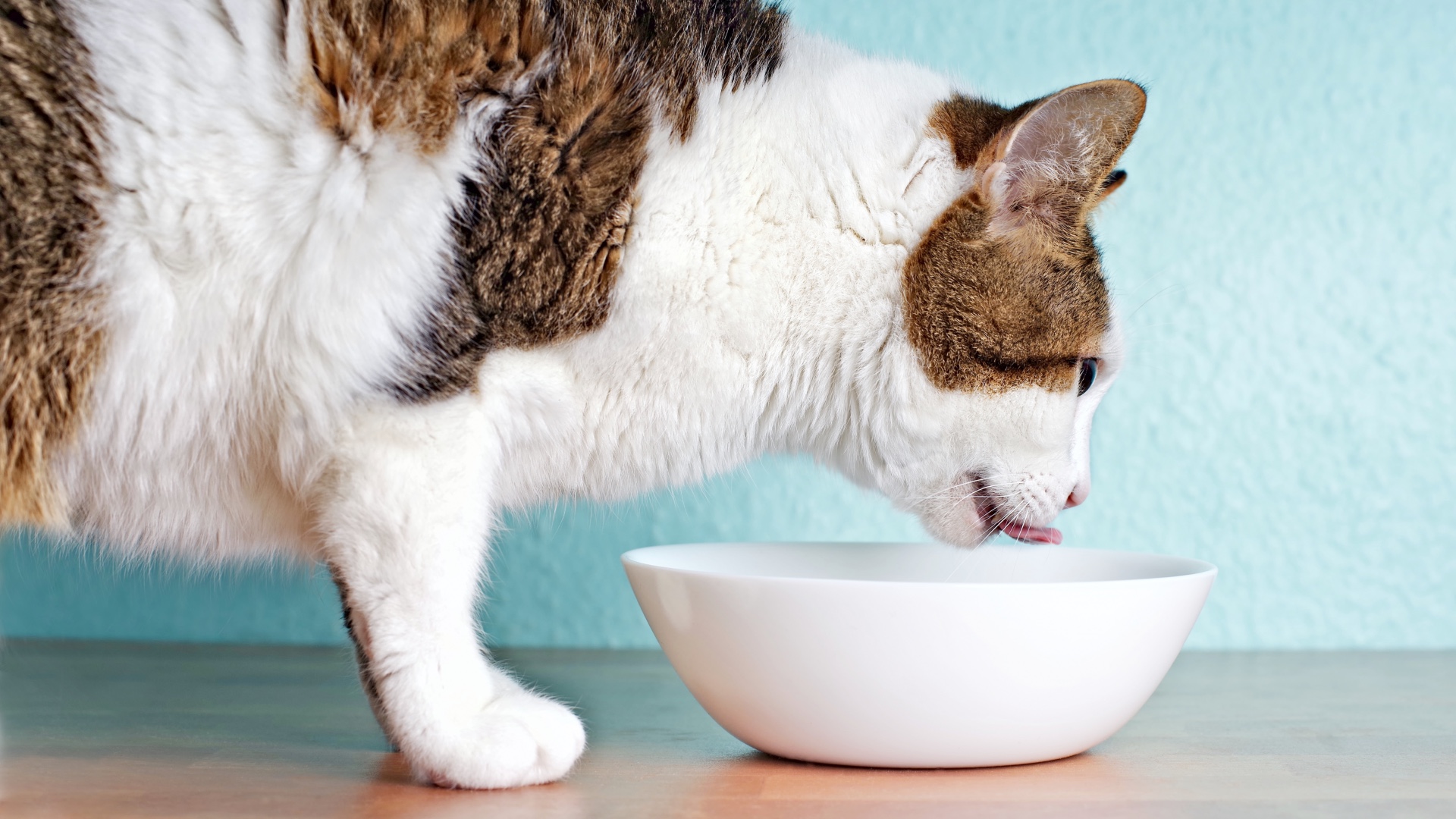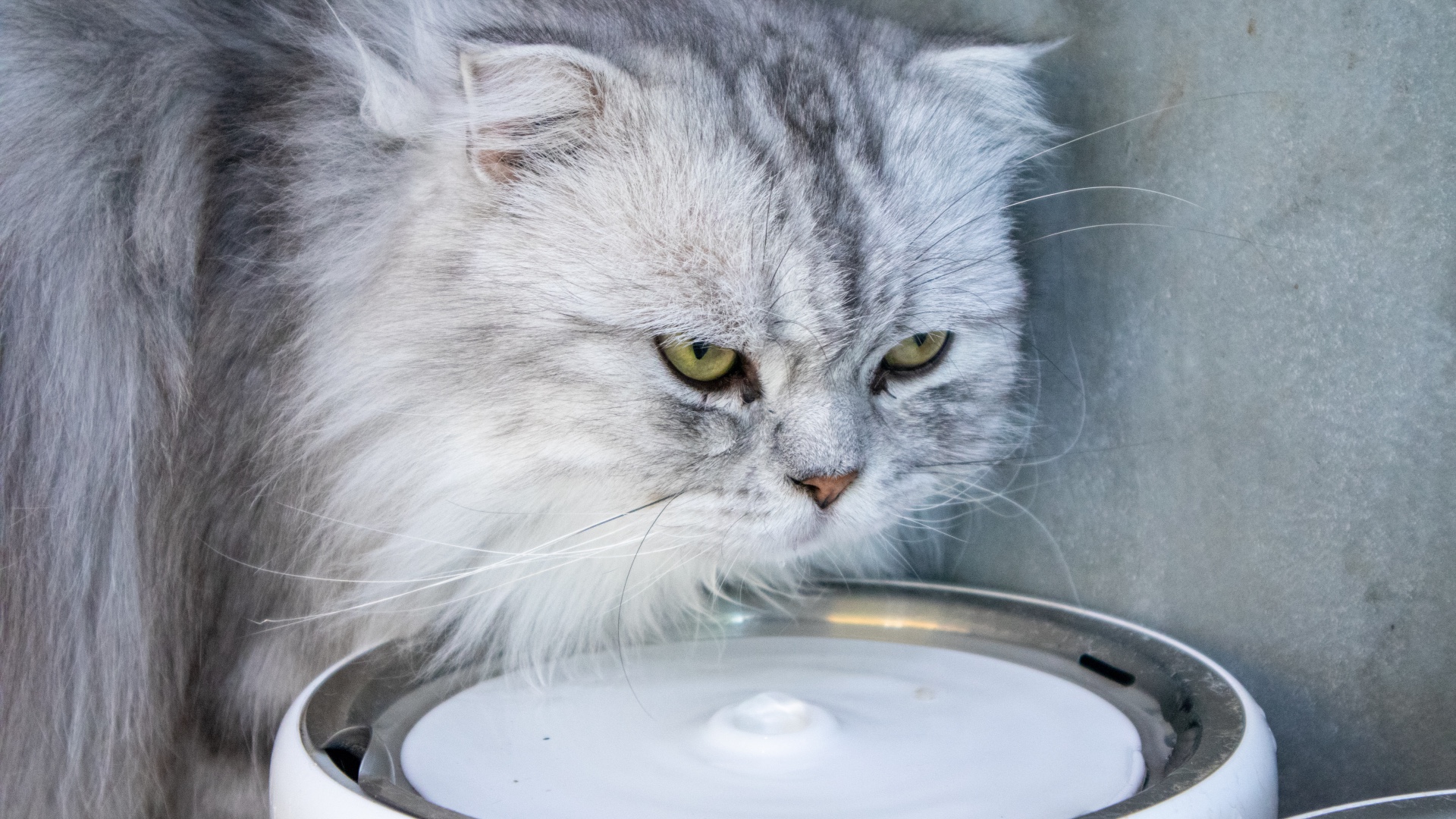How to stop a cat from spilling their water bowl and why they do it
Wondering how to stop a cat from spilling their water bowl? Read on as expert vet Dr. Hannah Godfrey reveals her top tips

Trying to figure out how to stop a cat from spilling their water bowl is a common problem facing a lot of pet parents, and while there isn’t a one-size-fits-all approach, there are plenty of things you can do to prevent this issue from recurring.
You may find yourself wondering is my cat sick if they’re engaging in this behavior on a regular basis — that’s certainly something worth checking out (and we highly recommend you do see a vet if you’re concerned about changes in your cat’s behavior), but other causes can include things like boredom or your feline friend simply having a fascination with water.
Whatever the reason, keeping your cat hydrated is vital for their health and wellbeing (especially if they’re eating the best dry cat food and their water bowl is their only source of fluid), so making sure it doesn’t all end up on the floor is incredibly important.
To help you figure out why your cat may be spilling their water bowl, we spoke with Dr. Hannah Godfrey to get her expert opinion on the most common reasons cats engage in this behavior and how you can put a stop to it. Read on to find out what she had to say…
Why does my cat paw at her water bowl?
Why does my cat paw at her water bowl or fountain is a common question amongst pet parents, so before you start trying to implement strategies to get your cat to stop spilling water, it can be a good idea to figure out the reason why they’re engaging in the behavior in the first place.
While most breeds of cat hate being submerged in water, many of our feline furkids find observing moving water to be pretty fascinating, which is why you might have noticed your cat staring at a fountain or trying to dip their paw under a running faucet.
Cats evolved to drink from free-flowing rivers and streams, so their fascination with the wet stuff is firmly embedded in their DNA, but their reasons for spilling it are somewhat more complicated.
Get the best advice, tips and top tech for your beloved Pets
Is your cat bored? Well, they may well be if they're pawing at their water bowl or spilling it completely. "Your cat might paw at their water bowl if they're feeling playful or bored," says Godfrey. "Cats can find fun in almost anything, and the fact that water reacts to their movements makes it an obvious choice at playtime. However, it's best not to assume that your cat is just playing and rule out more concerning causes.
"Ensure your cat isn't pawing at their water bowl to check where it is – this could indicate a problem with eyesight, balance, or coordination. Equally, going to the water bowl frequently but not drinking could be a sign that they're feeling nauseous or have pain in their mouth that's putting them off having a drink."
Why does my cat keep knocking over their water bowl?
"If your cat regularly knocks over their water bowl, it could be that they're struggling to drink from it in its current position — perhaps it's too high or too low for them, or they don't feel stable and safe enough to drink from it," explains Godfrey who goes on to add that if your cat's eyesight isn't as good as it used to be, or they have sore joints that stop them from getting into a comfortable position to drink, they might also be a little clumsy.
"On the other hand, they might knock their water bowl over as a form of play or as a way of getting your attention — remember, if you give them your full attention and a big reaction when they do it, even if it's a negative one, you're inadvertently encouraging them to do it again," Godfrey says.
How do I stop my cat from spilling their water bowl?

If you suspect your kitty is spilling water due to a health issue or lifestyle change, we recommend speaking with your vet in the first instance. But even if that is the reason, you’ll still want a solution in the meantime to help make your life a little easier. Here’s a few of our favorites:
1. Get a heavy-bottomed bowl
For serial spillers, the best deterrent is to invest in a weighted water bowl. These tend to be made from stainless steel or ceramic, and according to Godfrey, their heaviness makes it harder for your cat to tip over. "A heavy-bottomed bowl will keep the center of gravity low, making spillages less likely."
As a bonus, they tend to be incredibly durable and well constructed, so if you want a water bowl that’s going to go the distance, these are a great choice. Whatever bowl you choose, make sure it’s wide and shallow as this will help prevent whisker fatigue in cats.
2. Invest in a feeding station
You could also try a feeding station that has space for food and water, like the Neater Feeder Cat Bowl. This has a high back and sides that contains splashes and any excess water gets filtered down into a tray below. Once your kitty has finished eating, remove the tray and discard the water.
"Certain feeding station styles will help to contain spills, but you should still keep an eye on your cat's drinking behavior so that you spot any signs that they're struggling," advises Godfrey.
3. Consider a pet fountain
The best pet water fountains are the purrfect way to give your kitty 24/7 access to fresh flowing water. Not only is a pet water fountain designed to be sturdy, but unlike a bowl, there’s none of the accessibility issues.
According to Godfrey, "a water fountain could be the answer for cats who prefer drinking from a moving water source and choose the faucet over their bowl."
4. Place something under their water bowl
Okay, so it’s technically not a solution to stopping water spillage, but placing a tray under your cat's water bowl will help contain any water that goes rogue and make cleaning up that much easier.
5. Fill the bowl with less water
We know this one sounds like common sense, but sometimes spills are simply the result of the water bowl being too full. Try reducing the amount of water you pop in your kitties bowl and see if that makes a difference.
"For those who don't leave their cats for long periods, offering smaller amounts of water frequently could help prevent spills," agrees Godfrey, "but you must keep up with your cat's hydration needs."
6. Keep the water fresh
You'd be surprised how quickly the water in your cat's bowl can become contaminated with dust, food particles, fur, and other debris. Spilling water may be a sign from your kitty that their water is tasting a little stale and they'd like some fresh H20 stat!
Your pet needs constant access to clean and fresh water and unless you have a pet water fountain that takes care of that for you, you'll need to change their water at least once a day.
While frequently water spills can be frustrating, most of the time your kitty isn't doing it to annoy you. It's true that some may make a game out of it, but it's more than likely a result of the bowl not being accessible to them and in some instances the behavior could be being caused by a mental or physical health issue.
If you've ruled out the latter, making some of the above changes will help eliminate water spills and make getting their daily fluid intake an easier and more comfortable experience for your fur baby.
You might also want to learn how long cats can go without water and what should cats drink. Or, find out why cats like running water and do kittens drink water

Kathryn is a freelance writer who has been a member of the PetsRadar family since it launched in 2020. Highly experienced in her field, she's driven by a desire to provide pet parents with accurate, timely, and informative content that enables them to provide their fur friends with everything they need to thrive.
Kathryn works closely with vets and trainers to ensure all articles offer the most up-to-date information across a range of pet-related fields, from insights into health and behavior issues to tips on products and training.
When she’s not busy crafting the perfect sentence for her features, buying guides and news pieces, she can be found hanging out with her family (which includes one super sassy cat and a kitten), drinking copious amounts of Jasmine tea and reading all the books.
She has written for a range of publications, including Fit&Well, Top Ten Reviews, LiveScience, Goodto, and Product Hunt.
